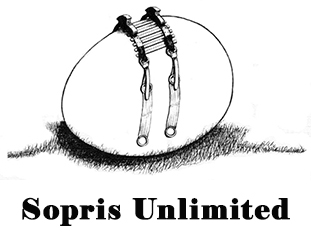Instructions for the
Sopris Chest Strap and Breeching
Sopris Chest Strap
The chest strap is used to insure that the saddle does not move rearward when your animal is going up steep inclines. A chest strap is also recommended when packing animals in a string to keep the saddle from being stripped off the rear of your lead animal.
Placing the Chest Strap:
Clip the metal snaps to the front saddle cinch rings.
The chest strap should be centered and placed between the windpipe and the shoulder joint. Tighten the chest strap snugly.
Connect the Diagonal Straps to the buckles on the saddle. These straps hold the chest strap up and in place.
Sopris Breeching
The breeching is used to ensure that the saddle does not move forward while going down steep inclines. The breeching can also be used as a training harness for larger animals when you are alone and trying to get your animal through an obstacle or into the trailer; after saddling and attaching the breeching, clip a lead rope on the halter ring and one on both forward cinch rings and pull the three ropes together.
Placing the Breeching:
Begin by standing on the animal's left side with the breeching completely disconnected from the saddle. Later you will be able to leave the rigging on the saddle if you choose.
When using the Roughy or other frame type saddles put the Loop End of the strap through the arch of the rear saddle horn in the direction of the animal’s head, and then loop it back over the top of the horn. A small snap replaces the loop for use on our Lumbar saddle. Connect this snap to the Pack String Ring at the rear of the saddle.
Connect the metal breeching snap to the rear cinch ring.
Hold the breeching below tail level with and with the free snap in your right hand, walk around your animal to the other side and clip in that snap. If unfamiliar with the animal be aware of a possible kick. He may also swing toward you as you bring the breeching around (this is to your advantage). Connect the snap to the other rear cinch ring.
The correct breeching placement is on the hams. For example, on a male llama this would be below the testicles. On a female, below the vulva.
Connect the Diagonal Breeching Straps to the rear cinch buckles pointing toward the rear of the animal. Tighten these straps only enough to keep the breeching from riding up toward the llama's tail. Too tight and you may be impeding the rear leg movement.
Snugly tighten the breeching straps connected to the saddle rings when in use.
Walk your llama around to get him used to the breeching. He may dance and possibly kick a bit at first. Repeat the entire process until he is comfortable with it. You are ready for the panniers.
